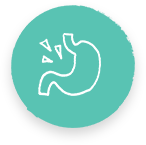ABOUT OVARIAN CANCER
When living with or caring for someone with ovarian cancer, educating yourself on the condition can help you become familiar with what to expect. Select a topic below to learn more.
What Is Ovarian Cancer?
Generally, cancer occurs when cells inside of the body begin to abnormally grow and spread. Ovarian cancer is a type of cancer that can originate in the ovaries or the fallopian tubes.1



women in the U.S. will be diagnosed with ovarian cancer annually2
Types of Ovarian Cancer
The ovaries are primarily made up of germ cells, epithelial cells,
and stromal cells. Because cancer can originate in each type of these cells, there are several types of ovarian cancer.1,3
| Epithelial Ovarian Cancer3 |
|
| Germ Cell Carcinoma3 |
|
| Stromal Carcinoma3 |
|
| Small Cell Carcinoma of the Ovary3 |
|
Recognizing Ovarian Cancer symptoms
Because early diagnosis is key, it is important to recognize the signs of ovarian cancer.4 This can be difficult because some of these symptoms are similar to common health conditions.5 Therefore, it is very important to listen to your body and note any persistent irregularities that may arise.
| Most common symptoms5 |
|
| Other symptoms6 |
|
| These symptoms are more likely to be linked to ovarian cancer if they are5 |
|
Similar to first diagnosis, symptoms of recurrence may include5:

Abdominal pain,
swelling, or bloating

Urinary Issues

Fatigue

Pelvic & lower
back pain

Changes in
bowel movements

Elevated
CA-125 Levels
Talk to your doctor about routine gynecologic care and annual pelvic exams, as screening is recommended to detect for recurrence.7
Ovarian cancer diagnosis
Many symptoms of ovarian cancer are also common ailments. It is important to be persistent and proactive in keeping your doctor informed to help foster earlier diagnosis. This is especially critical if common ailments like food sensitivities and gastrointestinal complications have been ruled out.5
A variety of tests can be used to diagnose ovarian cancer8 |
|
| Examples of tests8 |
|
| PAP smears conducted during physical examinations do not identify ovarian cancer.8 | |
ovarian cancer Stages at Diagnosis
To stage ovarian cancer, tissue samples are taken during surgery. Ovarian cancer is typically given one of 4 stages at diagnosis9:
who is at increased risk for ovarian cancer?
There are several risk factors that can increase or decrease the likelihood that a person will develop ovarian cancer.
| Factors that increase risk10 |
Genetics:
|
Drug Use:
Others:
|
| Factors that Decrease risk10 |
Fertility-related:
|
Drug Use:
|
Understanding family history
Can ovarian cancer run in families? |
In short answer, yes. One of the biggest factors that can contribute to an increased risk of ovarian cancer is family history. Many people don’t think to associate family history when dealing with a cancer diagnosis. The reality is, if someone in your close family has cancer, you may be at an increased risk for that cancer as well, due to certain genetic characteristics.11 This is especially important for those in certain racial and ethnic groups, such as African Americans, Hispanics and Asians. In fact, non-Hispanic white people are more likely to be referred for genetic testing due to family cancer history than all other ethnicities.11 Minority patients were more likely to utilize genetic services following a cancer diagnosis and less likely due to family cancer history.11 |
How does your family history impact your risk? |
Within each and every one of us are genes or parts of DNA that carry the information needed to make a protein.12 Each person will inherit a copy of a gene from each parent, and it is our genes that determine virtually everything about us – the color of our hair, how tall we are, and whether or not we may have an increased risk for certain diseases, such as ovarian cancer.10,12 It is important to note that you can inherit the risk of ovarian cancer from your mother or father.10 |
How do I learn more about my family history?13 |
The best place to start is by having a conversation with those in your close family. Here are some things you should find out from close family members, to assess your risk of developing diseases, such as ovarian cancer:
This is also important to note for any of your close relatives who may be deceased. Other places you can look for information are:13
Some families may be reluctant to have these types of conversations. If you are finding it hard to discuss this with your family, consider these tips:13
Talk to your family members about their risk of certain diseases, such as breast and ovarian cancer. Learn more about genetic characteristics and testing, here. |


